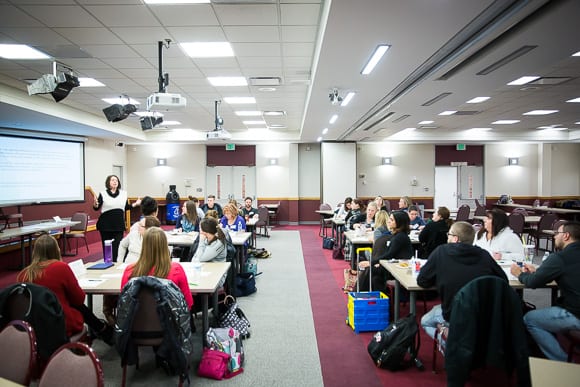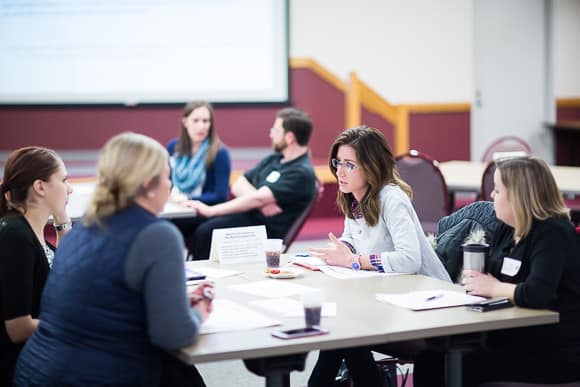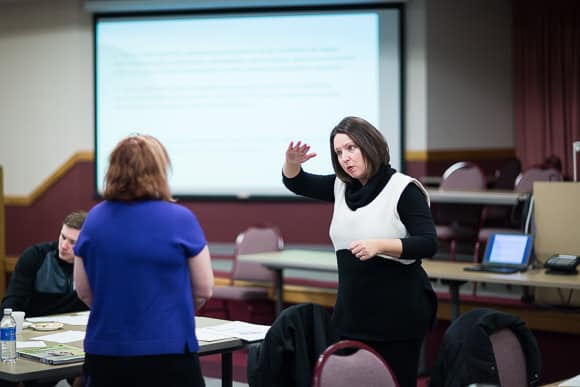This article originally appeared in Second Wave, a Michigan-focused online magazine, on November 9, 2015.
In early November, Gov. Rick Snyder signed new rules for evaluating teacher performance into Michigan law. Senate Bill 103 calls for research-based evaluation for Michigan educators, requiring school districts to establish performance evaluation systems that focus more on student growth and less on student test scores. But evaluation is only one part of the story. What are districts and administrators currently doing to support teachers before the evaluation even begins?
She’s got an office, but a high school principal in Farwell is rarely in it. Instead, she’s walking the hallways between classes. She gets updates on basketball scores and how the choir concert went from students, sure. But almost more importantly, Principal Dee Yarger is connecting with her teaching staff. In what might seem like a fleeting moment to an outsider, some really meaningful stuff happens: feedback.
There are 100,000 teachers in Michigan. 100,000 professionals charged with leading classrooms and shaping young minds. 100,000 in a profession where the nature can tend to be closed-door and independent, making the crucial feedback process incredibly challenging. Collaboration, a key component in improving teaching outcomes, takes serious work for teachers on top of an already very demanding job.
It’s no wonder we hear about Michigan’s teaching workforce feeling unsupported and undervalued. We expect them to do it all. And it just simply isn’t realistic for the administrators to those 100,000 teachers to all walk the halls as Yarger does at a small school in Northern Michigan to foster those moments of collaboration.
Study after study indicates teachers are the single most important school-based factor when it comes to student learning. The problem, according to some experts, is that there is no silver bullet as to how—despite the critical role they play—to uniformly address teacher support and evaluation. That’s where conversation and engagement come in, says Michelle Richard, senior consultant at Public Sector Consultants, a Lansing-based public policy firm and authors of Building a Brighter Future: Recommendations for How to Improve Michigan’s Education System.
“The question becomes how do we leverage what we know to help students succeed,” she says. “We know that we need to be talking more about educators than education in general, but it takes a long time to help 100,000 people get better at their jobs.”
‘Helping people get better at their jobs’ has historically been evaluated on a binary system, categorizing teachers as either “satisfactory” or “unsatisfactory.”
“We know there is variation,” says Richard. “Ask any teacher, student or parent and they’ll tell you where a teacher has room to improve. What we’re struggling with is how to account for and measure the diversity. We can’t have this blanket system and hope that it improves instruction.”
Though strides have been made in recent years with regard to evaluation, feedback and support (Michigan’s new State Standards and Senate Bill 103), there still isn’t a solid playbook. And if a performance conversation is only brought to the table once a year, progress can be limited. Direct conversations throughout the year can start to move the needle, but in the eyes of education experts, aren’t the full solution.
So where can we find the solution to improving not only evaluation for teachers but meaningful support? For many tackling the solution across the state, it’s a blend of art and science.
Meeting the needs of teachers where they are
School districts have to get creative when you consider the number of teachers, administrators and students they’re charged with supporting. Macomb Intermediate School District currently serves 21 different school districts, 10,000 teachers and 150,000 students.
“We try to meet the needs of the teachers where they’re at and provide them with experiences,” says Judy Pritchett, Macomb ISD chief academic officer. “One of the programs we use to do that is the New Teacher Academy, a professional development offering for our new teachers.”
The New Teacher Academy offers general support to new teachers, addressing things they may be struggling with, and provides opportunities for collaboration and connection. Empowering a new teacher can have lasting results in terms of retention and morale, which can only result in good things for students.
Teachers want to be in their classrooms, working amongst their students toward good outcomes, so Macomb ISD also offers professional development in the evening and on the weekends to support that driving need.
In Macomb County, hunger and poverty is an unfortunate reality. Many Macomb ISD students come to school not having eaten and with little exposure to print or vocabulary. Nearly half of Macomb ISD students qualify for free and reduced lunch. Understanding the student body and addressing barriers to learning is a priority for the ISD, and a major source of non-traditional support for its teachers.
“We provide support to teachers to help them understand how to work with students who are in poverty or students who face hunger and help them work toward success,” says Pritchett.
Building relationships for better outcomes
At Farwell High School, relationships are key. It’s the premise upon which its teacher mentorship program was established. And relationships are a major component to the school’s approach to feedback. It’s why Principal Yarger walks the hallways and is passionate about being present for her staff.
Yarger attributes the successes of Farwell staff to coming to know one another well through the mentor program. Yarger also draws on the hiring role of the administrator as a factor in cultivating a supportive culture.
“My number one job as an administrator is to hire right,” she says. “The relationship between teacher and school must be mutually beneficial for our students’ success.”
Yarger has set up a rigorous and tiered interview process to ensure her staff is made up of the most fitting personalities and qualifications possible.
Establishing a positive relationship right off the bat and maintaining it through the mentor program allows for crucial conversations, says Yarger.
“You have to have open and honest feedback and it needs to be done in the moment. Providing my staff with feedback isn’t about filling my calendar with meetings—it’s about my being visible and being where my teachers are. After we have that quick conversation in the hallway, I often see immediate change, both for the teacher and in student outcomes.”
Thinking (and learning) globally, acting locally
The Gerstacker Fellowship Program out of Saginaw Valley State University was established with the purpose of cultivating the next generation of leaders in education and equipping fellows with the tools to improve quality of K-12 education in Michigan.
“Gerstacker fellows meet one weekend a month for a year, zeroing in on a topic of leadership,” says co-director Carolyn Wierda. “After the program, they transfer their understanding to the world of education. More than 600,000 students have been impacted as a result of the Gerstacker program.”
One of the highlights and most valuable aspects of the program includes traveling to high performing international schools. Fellows get the opportunity to learn firsthand from schools that have a track record of strong education outcomes, immersing themselves in the culture of success and taking with them a new outlook on what that success could look like in the U.S.
“We’ve found that the countries we’ve visited share several common elements in their success,” says Wierda.
Those elements include: a united vision that is unwavering about education and divorced from politics; a common curriculum that includes a fair amount of local control; less frequent assessments to measure progress; a dedicated common understanding of and commitment to teacher education; and equity in funding based on the needs of communities and students as opposed to equality.
These international experiences not only shed light on ways to better support teachers but also offer inspiration for the fellowship participants who then bring the concepts back to their classroom or school district.
The public’s role
Wierda, a 34-year distinguished veteran in education, offers a final bit of insight about teacher support. It’s a tip for folks like you and me, so listen up if you’d like to make a difference.
“Business leaders and the general public need to ask directly how they can support teachers,” she says. “Very often we’re told how we should be supported when simply asking what it is teachers need and what their challenges are can provide meaningful results.”
According to Wierda, teachers generally know what’s getting in the way of their job. She suggests that those in the business world might offer connections to resources that could help reduce those challenges.
Beyond that, the public, who tends to point fingers at an overworked and under-resourced teaching force, has an even larger role to play.
“I believe that many teachers just simply wish to have support and respect for the work that they do,” says Wierda.
Michigan policy and individual solutions to teacher support continue to evolve, and it’s our role to foster a respectful and understanding environment for those teachers to thrive. Michigan’s children depend on it.
Photos: Teachers in Macomb Intermediate School District’s New Teacher Academy build relationships and skills to help Michigan students succeed. All photos by David Lewinski.





